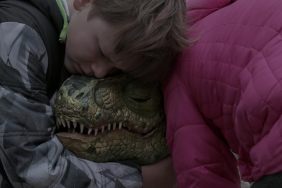Get ready for another outrageous comedy from the Farrelly brothers who know how to capture crude and shocking humor on the big screen. This time around, they show you what happens when you rush into marrying someone and then meet the person you really want to be with on your honeymoon in Paramount Pictures’ The Heartbreak Kid.
ComingSoon.net talked to Peter Farrelly and Malin Akerman, who plays Ben Stiller’s loveable wife at first, but soon after becomes the bride from hell.
Peter Farrelly: These are vibrators by the way so don’t even think about stealing them. (referring to the tape recorders)
Malin Akerman: Oh, well that one really looks like it is.
ComingSoon.net: You followed the 1972 film closely until a certain point and then you depart from the film and make it your own. Can you talk about remaking the original?
Farrelly: Somebody asked us to make that about five years ago. They came to us and said, “Do you want to do a remake of the ‘The Heartbreak Kid?'” “No, why would we, it’s classic.” Then about two years ago, someone came back and said there’s a new draft of “The Heartbreak Kid” because they really did something smart. It was written by Leslie Dixon and Scott Armstrong at separate times. What they’ve done is flip the original. The original was a very spunky girl who goes on this honeymoon and meets Cybill Shepherd. This one he marries Cybill Shepherd woman and goes on his honeymoon and meets a more down to earth girl. It really opened the door for us because, first it of all it was a different movie. We didn’t just want to remake “The Heartbreak Kid” as it was. It also helped the likeable factor. In the first one, as funny as it is, it’s a masterpiece, Charles Grodin was a cad. He’s just dumping the homely wife for the beautiful girl. Cybill Shepherd is a sociopath. He tells her I’m on my honeymoon and she’s like, “yeah, I don’t care.” So there’s a point where you don’t know what you’re rooting for. Once the wife is out of the picture you don’t really care if you get together. You follow it through because you’re curious, but you really don’t. This one, the likeability factor helped make it a fuller story for us and permitted us to put our kind of humor on it. If you don’t like out characters, our jokes don’t work. That’s one thing we’ve always known and go out of our way to set up these people. Also you said we departed at a certain point, well actually the first act was the departure. The original opened with them getting married and we felt we had to rewrite the entire opening to find out who he was. What was his background and really make him likeable. If you like him we can get away with stuff.
CS: Malin, those looked like the most strenuous sex scenes ever.
Akerman: They were quite acrobatic. Peter actually performed them for me before because I did not understand what he was saying. He’s like, “so Malin I want you to get on the bed and upside down with your head hanging down and your feet.” So he got on the bed and showed me.
Farrelly: You were trying to embarrass me though.
Akerman: Of course I was. It was really sexy when you did it. They were definitely some crazy positions that I’ve never tried myself and I don’t think I would.
CS: Was that real sweat?
Akerman: Was I sweating? I don’t know. I didn’t even see the sweat. Wow. What cut did you watch? I don’t know. I guess it was. It was hot on set.
Farrelly: They were moving around. It was a workout.
Akerman: It was a workout, definitely.
Farrelly: It was funny. It wasn’t like when you’re shooting a sex scene, we’ve never done it before, but when you are I imagine on a regular movie there’s tension. “Wow, it’s sex.” But this was so funny that it didn’t even seem to be about the sex. It was about the
humor. We closed the set and just had a couple of people on there as a courtesy, but it really wasn’t about the sex.
Akerman: No, it was too funny. We’d call cut and we’d all start cracking up. It was too funny. It’s like you’re in a really funny scene and you just happen to be having sex in it. So that wasn’t the initial thought. But of course it is awkward there with Ben and you’re like, “so how’s your wife?”

Farrelly: By the way, it also got better and better because the more comfortable they got as we were shooting it the more they got into it to the point where they were hitting each other, they’re hitting each other. They were batting each other around. They were really whacking each other there. It was fun to watch.
CS: Is nudity something you’re comfortable with?
Akerman: Comfortable enough. It’s never completely comfortable. I’m definitely not prudish when it comes to those things. If the scene requires it and it’s for a reason and it’s not gratuitous, then yeah. It’s gotta be real. In Europe and Sweden we see boobs on TV and it’s not a big deal. Everyone has them, everyone has seen them. They’re they are. Not completely comfortable. It’s not the first thing you want to do. I’m not like, “hey let me take my top off.” If the scene requires it then of course.
CS: How sympathetic are you to this character?
Akerman: She’s not a mean person. She does pull herself back and apologize so she knows she’s out of control sometimes.
Farrelly: Well that’s the trick. The trick is to love her and then you are kind of annoyed by her, then you start to hate her, then you start to like her again, then you kind of find the sweetness. That was the balance. We never wanted to lose her. We never didn’t ever want her to come to the point where you don’t give a s**t about her. Even at the end you do. It doesn’t work if you don’t do that. That was the real acting trick there because she has to show us. It’s not what she says or what she does; it’s just in her face. When she’s in bed looking at him like, “I love you Eddiebear,” you feel like this is a human being and despite everything, she’s going to be hurt and this isn’t good. We didn’t want to let Eddie off the hook. Forgive me if I’m repeating myself because you do so many rooms you can’t remember what you’ve said, but there was an earlier draft where she became a racist down in Mexico. She became a complete racist. We said, “what are you doing? No. That’s too easy because you’re like f**k her. Go to the other girl.” We didn’t want that. Eddie should be in a tough position so we dropped that. We always tried to keep her in the game.
CS: How much did that make you think about what guys have perceived as being crazy behavior?
Akerman: I do think it comes from the truth. I’ve watched it myself where a guy can give a compliment to a woman and she takes it as like, “what you think I look fat in this?” It’s not at all what they said. Women have a way of contorting things sometimes. We all have our moods, ups and downs. Or if the guy doesn’t say anything when you walk out with a new top and the guy has no idea why you’re mad at him. So of course, women are complicated. I think there is some truth. There are different stereotypes and truths that you put into scripts and of course she has a lot of them in this movie just to make her more of a character. I don’t mind it because I think there’s a truth to it.
CS: Was it fun to do the over the top scenes or was it hard to know where that boundary was?
Akerman: I loved it. It is quite over the top for most of the parts. You don’t want to go too far or push too hard or else it won’t be believable and you do want to make sure that you sympathize with her.
Farrelly: Part of the actor’s job though is to go over the top because when we’re making the movie we have a sense of where we’re going, but we we’re not positive. So you push all limits. You push them this way, this way, that way and then get over it and come back again so when you get into the editing room it’s like having all different kinds of colors and you can try them all out. The worse thing you can do is get there and realize you should have gone further. So basically you try to pop that ceiling where you know she’s over the top. That’s what good actors do. They’re not afraid to embarrass themselves. You don’t have to nail it every time. That’s why we try to keep a happy set where you’re not embarrassed to try it because if it’s stiff, everybody’s nervous. You want to nail it every time. We don’t want you to nail it every time. We want you to nail it and then push it and push it even further so that we know perfectly where it is. We see it on the tape. That’s the one. That’s the one. I don’t know when I’m filming. I kinda know it, but I’m not positive.

Akerman: There were a few times when Peter would come up and go, “I want you to go even further with him.” “Really further?”
Farrelly: I wasn’t sure if I needed it, but I wanted to have it because you don’t know.
CS: There’s a lot of people who think women, particularly beautiful women, are not funny. I would say you and your brother have disproved that theory. When did you and Bobby starting writing strong comedic roles for women?
Farrelly: Well a funny thing happened on “Dumb and Dumber.” That was our first movie. We were reading actresses for the Lauren Holly role. Mariel Hemingway said, “that’s a piece of s**t. This is garbage. You’ve got nothing here. Why would I want to play this women? There’s nothing. The guys get all the jokes. I’m just a nothing. You’ve got to punch this up.” She didn’t get the part. I remember thinking she’s right. You know what, we didn’t do that. There’s the traditional playing off the woman as the straight man thing, but you can also try to give the woman along the way more of a reality. We write better for guys. We’re guys. That’s what I write better for. I know guys. I know the way they think. You have to put yourself in the role of the women because by giving them humor you make them more real. You just get better at it as you go along. You remind yourself to try harder for that role because you do tend to get lazy when you’re writing female roles especially when they’re beautiful. You think that’s enough and it’s not.
CS: Did you have the snowball scene in “Dumb and Dumber” at that point?
Farrelly: Yeah, but as written, it was very unfunny. The studio was like, “what’s that scene?” “Uh he throws a snowball at her face.” “Why?” “We’re not sure why. He’s an idiot.” “But why would a guy throw a snowball at her face?” “Because he’s a moron.” In fact, the crew the day we shot that, it was late in the day. We’re tired and it’s starting to get dark. So we said okay let’s do this thing really fast and it’s not funny. He picks up a snowball and throws it. We said, “okay Lauren get down and put some snow on your face.” We were like, “‘what the f**k is this?’ It’s not until you cut it together and get into the editing room and find the perfect sound effect – which by the way it wasn’t until he hit her in the face we tried like 50 sound effects before we came up with Henry Aaron hitting his 715th homerun. It was the crack of the bat. Someone pulled it in for some reason and boom that was the sound. It sounded hysterical. The funny thing is about that is that when we testing that, and this is the great thing about testing movies, the audience tells us how far we can go. When we were testing it, he threw the snowball, hit her in the face and the audience goes crazy. She goes down and comes up and has blood under her nose. That’s how we had it originally. No more laughter. She’s hurt. Not funny. Dies, the rest of the scene. We go in and get rid of the blood. We test again and now she comes up with just snow on her face. We had another minute of laughter. So people say, “how far do you go?” We go as far as the audience lets us go because we test and they say “don’t do that, do this, don’t do that, do this.”
You’ll get to see what they did do when The Heartbreak Kid opens on Friday, October 5.









